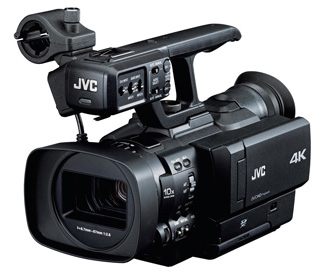JVC Responds to Changes in News, Production
WAYNE, N.J.: Dave Walton, assistant vice president of marketing and communications for JVC, points out that the company has been a major player in television news ever since newsrooms moved from film to tape, back in the 1970s.
"We have for years built traditional cameras, recorders, monitors, and that continues," Walton said. "What has changed is the overall way that people are using these products." While the rapid pace of electronic technology has enabled new products, "that technology and those products are changing based on habits, by desires of the marketplace… broadcasters are fundamentally changing the way that they acquire and distribute news."

JVC debuted the GY-HMQ10, the world's fi rst handheld 4K camcorder, in January. In addition to traditional early evening and late night television newscasts, "they're creating news for 24/7 operation which includes multiple screens, shooting news for not only the HD television screen, but computer screen and for the mobile devices," said Walton. "And hence, JVC is changing to better serve the needs of that market."
SMALLER, LIGHTER, EASIER TO USE
Some of the changes in JVC's products are appreciated by engineers and news photographers, Walton said. "We've seen an overall change from reliance on big, proprietary hardware that's amortized in five to seven years, down to smaller, lighter, easier to maneuver products that can create files in a variety of formats, because that's what's needed now in this new world of file-based communication."
Walton said station owners, the ones who pay the bills, have also had smiles on their faces due to the affordability of JVC's new camcorder products. "The difference is in the overall equipment cost," he said. "If you're spending $20,000-$30,000 for a camera, you have to put it on an amortization schedule that's longer because of the initial investment. If you're only spending $5,000-$10,000 for a camera that goes into the same application, you don't have to depreciate it over as long a period of time in order to be able to effectively use it."
That leads to more frequent equipment upgrades and more trade-ins. "It used to be that when a TV station got done with a camera, nobody would want it," he said. Nowadays, we're actually able to find homes for some of their existing equipment." Walton cautions that "the market for standard definition-only products is almost non-existent."
Those generalities about the marketplace are illustrated specifically in JVC's new GY-HM150 Compact Handheld 3-CCD Camcorder. Based on the company's GY-HM100, it features a new encoder that delivers not only improved HD recordings, but adds support for standard definition. The SD/HD capability future-proofs stations not yet ready to convert their field news coverage to HD. Its dual card recording capability creates an instant backup copy of footage as it is shot. That allows feeding back the story incrementally for Internet distribution and station news updates, while maintaining a complete copy of raw video for station newscast editing.
AFFORDABLE 4K
JVC has also seen an opportunity for an affordable camcorder for 4K digital cinema acquisition, debuting the GY-HMQ10, the world's first handheld 4K camcorder in January. "4K is actively being used in high- end production and we saw the need for a smaller, self-contained camcorder that could, in some cases, augment the larger specialized 4K cameras," said Walton. "Our 4K camcorder combines the ease of use of a point and shoot camera with the incredible capability of recording four times the resolution of full HD at 60 frames per second. While the market for such a product is limited, we see a significant growth opportunity as more producers explore this exciting new world of 4K. It's like HD was almost 20 years ago."
Walton said JVC has identified another broadcast market opportunity to fill: Blu-ray recorders. "We have several models, and just introduced the SR-HD2500US Blu-ray Disc and HDD Recorder. Broadcasters will be especially interested in it because it has HD-SDI inputs and outputs, and given the reduced cost of recording on solid state, nothing can compare with a $3 Blu-ray disc that can hold nearly 50 GB of data. So there are some advantages of having standalone recorders with removable media, inexpensive, and we're able to offer that with our Blu-ray recorder."
For monitors, JVC will introduce the DT-X71 AC/DC Portable Monitor, designed as an affordable, high-quality solution for field and studio applications.
For several years, JVC's IF-2D3D1 Stereoscopic Image Processor, a real-time 2D to 3D converter, has been a favorite for live and live-on-tape 3D productions, allowing producers to integrate 2D camera angles into the 3D production. Technology that went into that product has spawned a new, as yet unnamed, 2D to 3D workstation.
"We've been working with 20th Century Fox in developing this workstation," said Walton. "The quality is quite stunning, it's well beyond anything you could do in real-time." Converting 2D motion pictures to 3D can be an expensive process for studios, but Walton estimated JVC's new workstation could cut the cost by around 90 percent. "If it would normally cost you $20 million to convert a movie that's 120 minutes long, we might be able to bring that down to $2 million."
For 3D camcorders, the company will return with its GS-TD1 3D camcorder, that "produces very, very acceptable quality 3D at the lower end," Walton said. The one-piece 3D camcorder was introduced at CES in 2011. "We have not pursued higher-end 3D specialty products," Walton added. "We've kind of left that to others."
JVC will be in Booth C4314 in the Central Hall.
The professional video industry's #1 source for news, trends and product and tech information. Sign up below.
